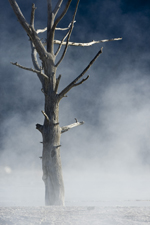
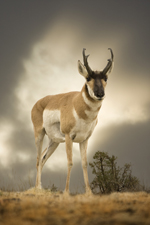
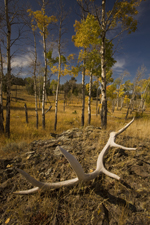



Our trips this fall marked our 20th year of doing fall trips to Yellowstone, and as we expected it was a very rewarding experience. In truth, it was also one of our hardest, for the first week was unnaturally warm -- or hot, and elk were uncommon, especially during the first and warmest week. While this made elk, and some other large mammal, photography difficult, it forced us to shoot 'outside the box' and our groups did some wonderful work of landscapes that we normally have less time to devote to. We had several 'veterans' of past Yellowstone trips on both trips, and while everyone commented upon the lack of elk, everyone enjoyed the shoot for the diversity we enjoyed.
We did two back-to-back trips this year, and each had its unique highllights. On Trip One, we had a northern pika that was, without doubt, the best we've ever had. Pikas are a member of the rabbit, or lagomorph, family, but the pika resembles a round rodent like the South American chinchilla. Like all rabbits, pikas do not hibernate but instead gather grasses, flowers, and other plant material all summer long which they store under rocks or boulders to feed upon during the winter. They inhabit rocky areas, often talus slopes, and where they encounter people they can become fairly tame. This pika, found near a picnic area, was the tamest we've ever seen, and it offered a tremendous shooting opportunity. Illustrative of how Yellowstone can change, we only had the pika one time, and although we visited the area several more times during the two weeks we never saw it again.
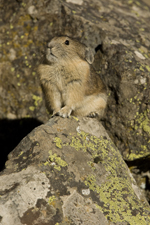
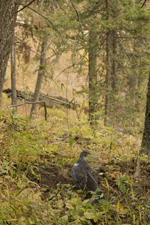
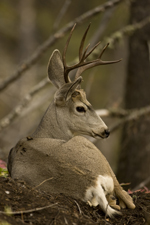
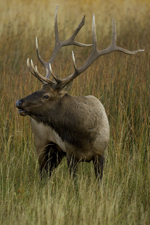
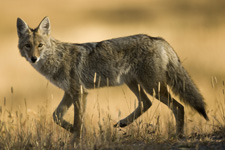 Coyotes
were uncommon, but we had one extremely cooperative coyote on
Trip One that repeated criss-crossed a road before finally settling
in a meadow before us where it posed and hunted grasshoppers.
On another occasion, at a distance too far for good shooting,
we had a coyote actively hunting grasshoppers, often leaping high
in the air to snatch a grasshopper as it tried to fly to safety.
On Trip Two, we only had one chance, and that coyote proved very
skittish. Mary and I had dropped off the group where we thought
the coyote would hunt, and then headed down the road to another
parking area where the group could meet us as they followed the
coyote. We lsot sight of the coyote, so Mary and I split, and
I headed uphill and Mary down, hoping to spot the coyote. As it
turned out, it was coming my way, paralleling the road and our
group that were trying to follow it and keep it in sight. I quickly
guessed at a position where I hoped it might trot in to me and
waited, and within a minute it was trotting down the trail, directly
to me. I was set, camera in place, and I was motionless, but incredibly
the coyote still spotted me and, after a moment's pause, did a
U-turn and ran back to where we had originally seen it.
Coyotes
were uncommon, but we had one extremely cooperative coyote on
Trip One that repeated criss-crossed a road before finally settling
in a meadow before us where it posed and hunted grasshoppers.
On another occasion, at a distance too far for good shooting,
we had a coyote actively hunting grasshoppers, often leaping high
in the air to snatch a grasshopper as it tried to fly to safety.
On Trip Two, we only had one chance, and that coyote proved very
skittish. Mary and I had dropped off the group where we thought
the coyote would hunt, and then headed down the road to another
parking area where the group could meet us as they followed the
coyote. We lsot sight of the coyote, so Mary and I split, and
I headed uphill and Mary down, hoping to spot the coyote. As it
turned out, it was coming my way, paralleling the road and our
group that were trying to follow it and keep it in sight. I quickly
guessed at a position where I hoped it might trot in to me and
waited, and within a minute it was trotting down the trail, directly
to me. I was set, camera in place, and I was motionless, but incredibly
the coyote still spotted me and, after a moment's pause, did a
U-turn and ran back to where we had originally seen it.
I mention this because as it approached I weighed whether or not I should get down and shoot from a lower angle, near coyote-level, or keep standing where the high grasses and vegetation would not obscure the coyote as it approached. I elected to stay standing, but I assumed that my motionless shape would go unnoticed, at least until I fired my first shot and the coyote heard the camera's click. I was wrong, and I'm still surprised that the coyote recognized my camouflaged form so easily. Something, perhaps, for you to keep in mind, too.
Bison numbers were down, too, but that may have been just coincidence since bison migrate and may simply have been beyond a ridge that we couldn't see from the roads. However, bison are culled when they leave the park because of a fear of spreading a disease that bison harbor that might, just might, be transmitted to cattle. Interestingly, the same disease, brucalosis, also infects elk, but authorities do not kill this cash-producing game animal when it leaves the park. At any rate, we did have two great experiences with bison on Trip One, with a river crossing in Hayden Valley, and a great dust bath and courtship activity toward Nez Perce crossing. On Trip Two, we never saw a bison herd, but one great bull, grazing in a meadow below a snow-covered peak on a blue sky day, was such an iconic image that, for many, it was one of their favorite shots of the trip.
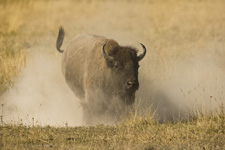
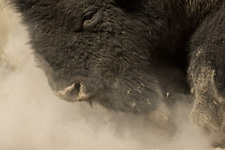
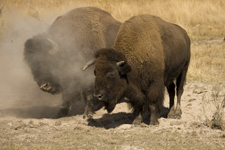
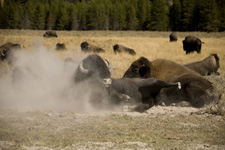
We did well with pronghorns on both trips. Pronghorn are also called a pronghorn antelope, and although they resemble an African antelope both in looks, habit, and certainly their incredible speed, they are not true antelope but instead are more closely related to goats. They are prairie residents, and can cover open country incredibly quickly; so fast, that it is hopeless to follow a pronghorn that is uncooperative. The trick to working pronghorn is to keep clear of their discomfort zone, to move slowly and to allow them to grow accustomed to you. We did this with pronghorn on both trips, and those experiences, of slowly working closer, observing and patiently waiting, was the trip highlight for several photographers on both trips. We love working animals in this way, and, just as important, leaving them just as relaxed when we're finished photographing.
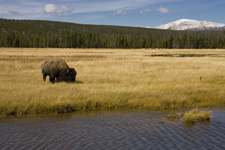

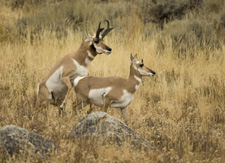
 One
of the trip highlights, occuring on Trip Two, was the return of
the Trumpeter Swans to Swan Lake Flats. For several years a pair
of swans graced this lake but the birds had disappeared the last
two or three years. Previously, we could always find a family
or two along the Madison, but those birds eventually disappeared.
Yellowstone, without swans, seemed a bit empty to us, so we were
extremely excited to find two swans on the lake one morning. The
birds were far away and didn't look too promising, but when a
group of Canada geese flew by, offering some nice flight shots,
we were lured in to staying longer. As the time passed, the swans
slowly worked closer until they filled our frames, preening their
feathers in the shallows by our shoreline. Both Mary and I shot
far too much, but we were so excited to finally have the swans
back and ... well it's only pixels, we could always delete and
cull heavily!
One
of the trip highlights, occuring on Trip Two, was the return of
the Trumpeter Swans to Swan Lake Flats. For several years a pair
of swans graced this lake but the birds had disappeared the last
two or three years. Previously, we could always find a family
or two along the Madison, but those birds eventually disappeared.
Yellowstone, without swans, seemed a bit empty to us, so we were
extremely excited to find two swans on the lake one morning. The
birds were far away and didn't look too promising, but when a
group of Canada geese flew by, offering some nice flight shots,
we were lured in to staying longer. As the time passed, the swans
slowly worked closer until they filled our frames, preening their
feathers in the shallows by our shoreline. Both Mary and I shot
far too much, but we were so excited to finally have the swans
back and ... well it's only pixels, we could always delete and
cull heavily!
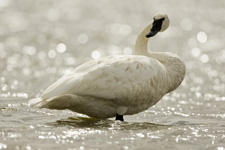
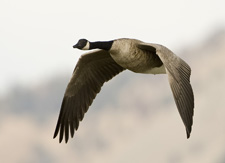
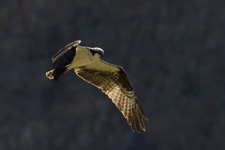
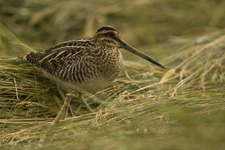
Birds offer a nice addition to our shooting, and this year a Common (Wilson's) Snipe was a surprising addition. Canada jays, Common ravens, dippers, mergansers, Stellar's jays, red-tailed hawks, great gray owls, great horned owls, long-eared owls, common robins, hairy woodpeckers, bald eagles, ospreys, great blue herons, sandhill cranes, and several other species are often encountered, although we've never filmed all of these birds on a single tour. This year, an osprey fished close, and, hand-holding, I got some nice shots just as I was about to put my big lens away!
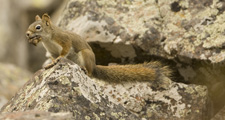 For
several photographers on Trip Two, some of the photo highlights
of their entire week were the small mammals - red squirrels and
least chipmunks. It is so easy to ignore these animals -- they
are common, or so it seems until you're trying to photograph one,
and one always assumes that they can be shot anytime. More importantly,
as wildlife photo subjects they are just as exciting and interesting
as the big trophy animals, if only one takes the time to actually
photograph them. I was so happy to see some of our photographers
so appreciative of this fact!
For
several photographers on Trip Two, some of the photo highlights
of their entire week were the small mammals - red squirrels and
least chipmunks. It is so easy to ignore these animals -- they
are common, or so it seems until you're trying to photograph one,
and one always assumes that they can be shot anytime. More importantly,
as wildlife photo subjects they are just as exciting and interesting
as the big trophy animals, if only one takes the time to actually
photograph them. I was so happy to see some of our photographers
so appreciative of this fact!
Because animal numbers seemed down, we maximized our shooting opportunities by photographing a variety of landscapes in ways, and with time, we never had the opportunity for in times past. Although Yellowstone is a highly visited, and indeed often over-crowded park, if you get off and out of sight of a road you are, essentially, in wilderness and, it would appear, virtually alone. Several times we photographed landscapes or wildlife that a dip in the landscape hid us from view and, in these times, we seemingly had the park completely to ourselves. It was a wonderful feeling.
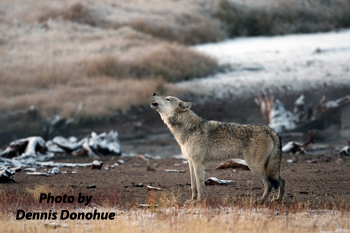
Which contrasted greatly at one location on Trip Two, where a
pack of wolves had killed an elk within eighty yards of the road.
I've always thought that some day, with the introduction of wolves,
someone would be lucky enough to be at a viewing area and have
a pack of wolves run down an elk right before their lenses. This
year it happened, and in a three hour chase, incredible observations
where made. At one point, the wolves paced the shoreline of a
lake while three desperate elk swam, neck-deep, alongside, and,
several times, wolves ran so close to the people they were within
forty feet. One photographer I spoke with worried that the elk
the wolves were chasing was about to run over him as the cow raced
by. That shooter had frame-filling head shots of the wolves, as
well as an incredible sequence as a wolf leaped into the lake
in pursuit of the swimming elk. Unfortunately, no one was at the
kill as it occured, as the chase continued south but ended close
to the road, which we passed as we traveled south.
We returned at 4PM, to join an hundred or more people (mostly photographers) all aimed at an elk carcass that was partially visible between the trees. We waited until 7 but the wolves never came, but as this was the best chance we had ever had with a group to get some shots of wolves up close -- relatively speaking, we thought it wise to stay. Nonetheless, Mary and I do not enjoy those types of vigils, not because we don't like to wait but because we don't care for the group/mob/masses/crowd where the wildlife experience seems a bit tainted. For us, and hopefully for our groups, we look for the special shooting opportunities that at least give us the feeling that what we're shooting is unique.
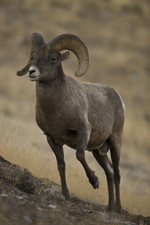
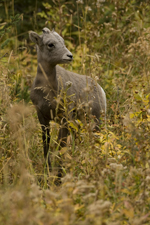
That feeling certainly occured on Trip Two, when a friend found a group of four Bighorn Sheep rams we had told him might be in a little visited area. He had checked once before, and so did I, when I had one of our participants drive my vehicle back to our motel while I did a speed-walk for a mile to check one of the likely hideouts for the rams. Both of us were unsuccessful, but on our last afternoon our friend found us in the park and told us he and his friend had just left the sheep! We packed up and headed out, and spent our last afternoon in a hidden hollow, not too far from the road but completely hidden, and there we shared a wonderful two hours with the four rams. Sheep are usually extremely tame and trusting, but will move off if pressured, and it truly was wonderful to be able to work the group alone, with all of our participants moving as one as we slowly meandered toward the sheep and stopped outside their discomfort zone.
Anecdotes about our landscape photography are less interesting, and accordingly I haven't written about our daily shoots. The accompanying portfolio should, as the saying goes, be worth thousands of words. However, I'd be remiss in not pointing out the fun we had in our landscape shooting in helping photographers 'see' images and to try new techniques. If your a wildlife shooter you may know what I mean -- you see that the scene is pretty, or interesting, but you just have no idea how to convey that in to an image. For Mary and I, it was fun to set people up at what we thought were the most powerful vantage points, or to have folks look through our cameras to see how we isolated the important parts of a scene to make an image. Sometimes we just did wild, creative shooting -- using slow shutter speeds for push-pull zooms, or lens twirls, or double-exposures (post production) that made an interesting stop into an incredible photo opportunity.
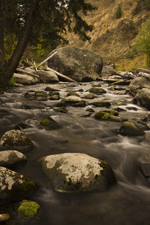
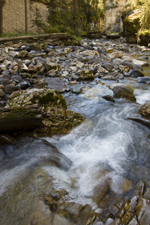
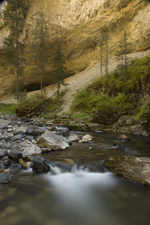
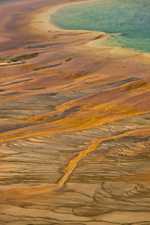
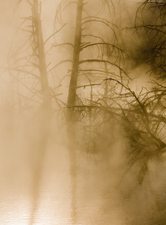
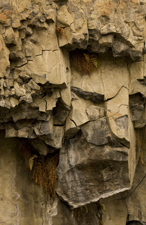
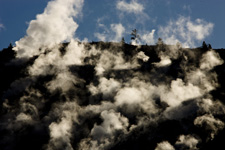
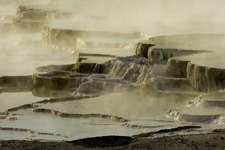
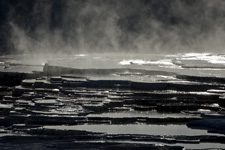
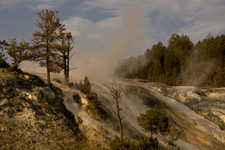
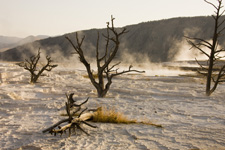
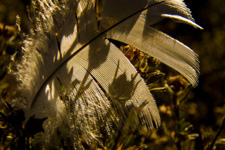
This aspect of Yellowstone offers so much, and is reason alone to photograph the park. We're known for our wildlife, and I think a lot of our participants join us because they expect to get great wildlife photographs. I'm fairly confident we meet everyone's expectation there, but wildlife is fickle, luck can be bad, numbers can be down, and shooting could be poor or disappointing. But the landscapes are always there, and they're worthy of a week dedicated to that alone. Indeed, one of my highlights for the last two weeks was when one photographer, a very serious and excellent bird and mammal photographer, told me how excited he was about shooting landscapes, and how his vision of the world has expanded, and with it, the wealth of subjects he could now photograph in addition to his favored animals. That was a gratifying statement to Mary and me!
As mentioned earlier, and commented upon in last year's 2007 Trip Report, elk were uncommon. I asked a ranger we've known for years, a 19 year veteran of Yellowstone, why the elk have disappeared from the previous hot spots around Gibbon Meadows, Elk Park, and Norris, as well as the valley that followed the Madison River. He believed that the introduction of the wolf accounted for the changes, as elk in the park were once overabundant and stressing the system. Our own exerience corroborates this opinion, since we've seen a steady decline of elk over the years after the reintroduction of the wolf. This change is not, necessarily, a bad thing, as the park's entire ecosytem is changing because of this. Coyotes are less common, as wolves often view coyotes as competitiors, but red foxes are increasing, since coyotes often kill foxes. Aspens and cottonwoods are regenerating in areas where they've been absent for ages, and with the new vegetation birds, long absent, are returning. Mule deer are more common each year, which might be due to more browse. Other factors may account for the fewer number of elk, including drought, hunting pressures, and grizzly bear predation on elk fawns.
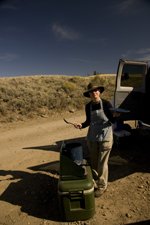 On
our last day our shooting kept us so busy that we didn't break
for a picnic lunch until mid-afternoon, where we decided to 'tailgate'
in the field rather than drive to a regular picnic area and table.
Doing so, fortune smiled, and our friends found us to tell us
about the bighorn sheep we'd have otherwise missed. That's Mary
taking a break from stirring her soup and chili!
On
our last day our shooting kept us so busy that we didn't break
for a picnic lunch until mid-afternoon, where we decided to 'tailgate'
in the field rather than drive to a regular picnic area and table.
Doing so, fortune smiled, and our friends found us to tell us
about the bighorn sheep we'd have otherwise missed. That's Mary
taking a break from stirring her soup and chili!
Next year, because of a scheduled trip to Antarctica where we'll be co-leading a trip for Joe Van Os's company, we had to compress our usual fall schedule and, accordingly, we'll only be able to do one Yellowstone Photo Tour. This is a popular trip, and an extremely rewarding one, so if you're interested please contact our office immediately. Since we're only doing one trip, the usual question - which week is best? - is moot. However, as this and our previous trip reports will indicate, it truly doesn't matter which week in September you visit Yellowstone. It is always good, and it is always different. For example, the week prior to our Trip One, Yellowstone was unseasonably cold. During our Trip One, Yellowstone was unseasonably warm, and, on Trip Two, the week started cold and gradually increased in temperature. The week following our second trip the weather was forcasted to heat up once again, so you just never know. But make no mistake, it is always good!